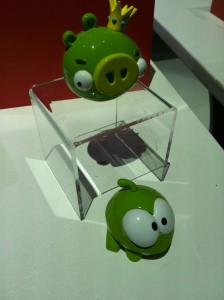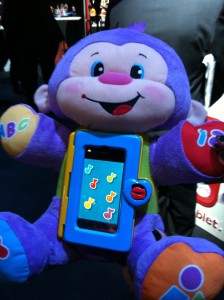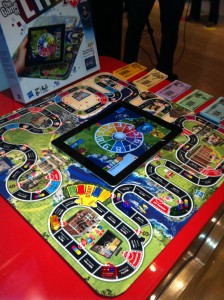Look who has her dancing shoes on!
Monthly Archives: February 2012
Did we learn nothing from Baby Einstein?
I was eager to read the front page New York Times piece on the use of digital technology in toyland by Stephanie Clifford. In Go Directly, Digtally to Jail? Classic Toys Learn New Tricks, Ms. Clifford reports on what we also saw as the major trend at toy fair. It certainly felt like you weren’t in the running as a toy unless you had an APP counterpart. Classic brands including Monopoly, Hot Wheels and Barbie will not be left behind in the dust of APP hits like Angry Birds.
While the article gives a good overview of Toy Fair that ended on February 15th, it misses any inquiry as to the value of such toys for children. The only mention comes from a manufacturer who makes toys based on the internet hit, Moshi Monsters. We agree with Michael Acton Smith of Mind Candy who notes, “We don’t want a world where kids are just staring at a screen for their play constantly.” The next question of course, is whether your child needs a plush or plastic representation of characters they enjoy on-line? Does such a real toy enhance their play experience or are they just a desperate play by the 21 billion dollar toy industry to stay in the game? Other questions come to mind: Is the virtual game worth hours of your child’s time? Does your tech savvy four year old really need to drive a specially designed Hot Wheels on your iPad? How much time, if any, should your 18 month old be on an electronic device?
Our concern is that such an article suggests to parents that this trend is the new toyland and designed for “technology-obsessed children.” If you want to play the game of Life with your kids, you’ll now need an iPad at the center of the game board. While the piece does discuss the income divide such expensive toys may produce, it misses any of the concerns raised by child development experts.
Unsettling for me, is that this type of reporting feels eerily like the early coverage of baby videos (the Baby Einstein series being the biggest of them all). The focus was on how popular they were becoming and how companies were making millions targeting this untapped market. It was as if the press just accepted the marketing spin that these videos will make your child smarter. The take away for parents was that you better buy a full library of these DVDs if you wanted your child to get into college. There was also a certain amount of fear built into these marketing messages. Even those parents not sure of the their value, felt compelled to buy them just in case. After all, who doesn’t want to give their baby every possible advantage. The videos, at under $20 a pop, were a very affordable golden ticket to the ultimate of sentences: “My kid’s going to Harvard.” Sadly, the coverage often lacked any focus on child development experts who were waving their arms to say that these videos were not beneficial. No one wanted to hear that these very easy to pop-in videos could negatively impact young children.
We are relieved that the value of these videos has been debunked. Contrary to the brilliantly seductive marketing machine around these videos, parents now know that their baby is not going to become fluent in four languages by watching the same video over and over again. In fact, what the research has shown is that screen time usually just gives kids an appetite for even more screen time. Our organization took a very unpopular position – we have never recommended videos for children under the age of 2. We were delighted when the American Academy of Pediatrics took the same position.
It’s really too early to tell how this new world of “blended” and “integrated” toy/digital experience will impact children, especially the very young. As these new toys start arriving for testing, we will have to look at them on a case by case basis. What is the content? Yes, your toddler can navigate a iPad like a pro, but how important is it? What other types of play are being discarded? One of our testing parents recently told me that when she took her kids to an indoor play center, the room was populated by kids sitting and playing with smartphones and tablets. There was serious bargaining going on to get the kids to unplug and play.
What we do know is that other types of screen time (whether it’s television, DVDs, video games) can negatively impact children. We have a sense that these even smaller screens – that are ever so appealing to young and old – will have similar issues.
As we wrote about earlier this month (Do kids really need toys to play with their APPs), we worry about reducing playtime to smaller and smaller play areas. Yes, handing off your phone to your three year old will usually buy some peace and quiet, but there also needs to be opportunities for kids to use their whole bodies to pretend. They should have art materials for expressing their creativity. And by art materials – we mean the kind where you get your hands dirty. Playing with blocks helps develop math and visual discrimination skills. And while we saw an APP for attaching to your child’s trampoline (no joking)…there is no APP that replaces physical activity for developing big muscles and coordination. Finally, we also know that very young children learn best through interactive experiences with other real people. Language development soars when babies and toddlers are engaged with other people talking, reading and singing with to them.
We welcome Ms. Clifford’s focus on this issue, but hope that going forward that the scope of inquiry will also address the value of this type of play.
Women in Toys honors Joanne Oppenheim with Lifetime Achievement Award
 I’m thrilled to share the terrific news that my amazing mother (and business partner) was honored last night with a Lifetime Achievement Award from Women in Toys. Joanne was recognized for being a true trendsetter in how we talk about the value of play and the importance of providing our kids with quality playthings. As always I’m so immensely proud to be her daughter. On a professional level, there is no better partner.
I’m thrilled to share the terrific news that my amazing mother (and business partner) was honored last night with a Lifetime Achievement Award from Women in Toys. Joanne was recognized for being a true trendsetter in how we talk about the value of play and the importance of providing our kids with quality playthings. As always I’m so immensely proud to be her daughter. On a professional level, there is no better partner.
Last night should have been that moment when you are surrounded by your peers in your industry and soak in that your work matters and has been appreciated. Sadly, my dad was hospitalized last night. It was one of those moments when life just throws you a curve ball.
My mom was so touched by the honor and thanks all of the members of the organization.
An amusing singing Beaver
Watch the video. He sings Justin Bieber’s Baby (new from Cuddle Barn). Sort of as if Justin Bieber and Alvin the Chipmunk had offspring!
Do kids really need toys to play with their APPS?
This is the 6 BILLION dollar question this year. If toy makers have their way, the answer will be a resounding yes. In fact, it seems that many are betting the farm on it. With APP sales exceeding $6 billion in 2010 and estimated to reach $25 billion by 2015, you can’t really blame them for wanting a piece of this mega pie.
The big take away trend of TOY FAIR 2012, that officially begins tomorrow at the Javits Center in New York City, is the arrival of digital “enhancing” toys. There’s even a whole new vocabulary: you’ll hear that your child needs toys that help “blend” their reality and digital play experiences. Clever new brand lines such as Apptivity (Mattel) or AppGear (WowWee) or AppMates (Disney).
But at the end of the day, does your 18 month old baby really need a bear with an iPhone for a belly? Does your four year old who loves Hot Wheels really need to have a special car to race on the surface of your iPad? Does your child need a plastic fishing rod so that he or she can “virtually” fish with an attached smartphone?
I was pretty cranky this week as I started previewing this new category. I couldn’t quite put my finger on why and then yesterday, after having visited both Mattel and Hasbro’s showrooms, it became clearer to me. I wasn’t exactly cranky, just a little bit sad. I love toys. I’m always excited to see what those clever toy makers are going to wow us with. What innovative uses of technology would we be able to share with our readers? Unfortunately, this new category feels like the toy industry is desperately trying to remain relevant in a world where even the youngest children (who are not even talking yet), can navigate their parents smartphones and tablets.
The question for us always comes back to whether the technology enhances the play experience. In other words, do you need a toy to have the same or greater amount of pleasure when playing Fruit Ninjas or Angry Birds? Is the APP experience lacking or less than optimal if you don’t have these 3D action figures? Does having an iPhone APP at the center of your game board really make playing a round of LIFE or Monopoly better? As with most new categories we review, the ultimate answer will be made on a case by case basis.
In the swirl of wow-look-what-we-can-do-now in toyland, it’s almost easy to miss the next important question. Is this toy developmentally appropriate? We know that handing off iPhones and iPads to very young children has become part of our culture. Parents often marvel at how well their kids navigate such experiences, and we all know that such a hand off can be particularly useful when you travel or on a tedious line at the grocery store. (I can barely make it through the Whole Foods line without my phone.) But now ask yourself whether it’s beneficial to extend that time by adding toys to the experience. What other real world play experiences are being missed by adding more screen time? While the technology is far too new for studies that research the impact on small children, at this point we see no reason why this screen time will be vastly different from television, baby videos, or video games and their negative impact on children. In other words, less will probably be more. And when you’re talking about very young children, none may be even better. Not a popular suggestion we know. As with most things, we have a sense that moderation is probably the most realistic goal.
One more thing. It also seems somewhat tone deaf to be suggesting in these difficult financial times that expensive technology must be acquired for playtime. I know we all have phones and according to the folks at Mattel, one in every five house holds owns an iPad – but still. From a consumer point of view, board games have always offered great value. Most games cost under $20. Now, that’s $20 plus the cost of your iPad or iPhone.
I feel much better now. And while I understand that toy companies want in on this booming business, I hope that all of those creative toy makers will remember that playing in the real world with wonderfully crafted playthings is still something to be valued.







